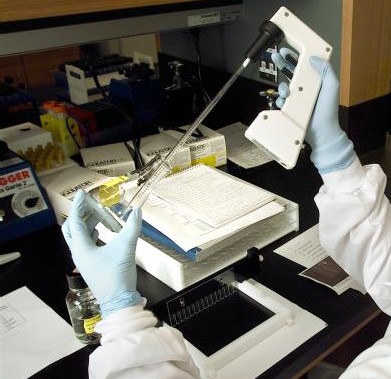Pulsed-field gel electrophoresis (PFGE) is the DNA “fingerprinting” method that scientists use to determine the source of bacterial outbreaks, both foodborne and Legionnaires’ disease (water-borne). If you are part of an outbreak, our lawyers can help you determine if you can sue for food poisoning.

How Does PFGE Work?
The DNA of the bacterial pathogen is digested into pieces with enzymes that are able to specifically break the DNA molecule into individual pieces. The digested DNA is placed at one end of the gel. A pulsing electric field applied across the gel drives the DNA pieces into the gel over a period of hours. The smallest pieces slip through the pores of the gel more quickly, so the pieces are separated as distinct bands in the gel, based on size. The resulting pattern of 30 to 50 bands, which resembles a bar code is the DNA “fingerprint.” This fingerprint is referred to as the PFGE pattern.
Foodborne Outbreak Investigations
Like human fingerprints, each bacteria and its offspring have a unique PFGE pattern. If two bacteria are found with an indistinguishable pattern, it is likely that they have a common source and may be part of a foodborne outbreak. A national computer database of these patterns is housed at CDC as part of PulseNet. Health investigators throughout the country submit these DNA patterns of pathogens that have made people sick to the database over the Internet. The computer then automatically scans previously submitted patterns searching for matches, i.e., indistinguishable DNA fingerprint patterns of pathogens that have made other people sick. If a match is found, a signal is given to the submitter that duplicate patterns are present and where they came from, so that an investigation can start to look for a common source.
Microbiological Proof in a Food Poisoning Case
The microbiological proof in a food poisoning case consists of several parts:
- Tests are run on stool or blood samples taken from people with symptoms of foodborne illness to determine if a foodborne pathogen is the cause. For example, if someone has bloody stools and other symptoms of E. coli O157:H7, tests are conducted to determine if the person has indeed been sickened by E. coli bacteria, and if the serotype of E. coli involved is O157:H7.
- Tests are run on any food or environmental samples collected by health officials to determine if the samples are positive for a foodborne pathogen.
- With bacterial foodborne pathogens – Campylobacter, E. coli, Listeria, Salmonella, and Shigella – DNA testing can be done to determine the genetic fingerprint (PFGE pattern) of the bacteria. If these patterns match, it suggests that various unrelated individuals may have been infected by a common source. If the PFGE pattern of the strain found in ill persons and in a food product match, it is highly likely that the food product is the source of the outbreak. Matching PFGE patterns are an important part of proving “causation” in a food poisoning case seeking money damages.
Our food poisoning lawyers are some of the few in the nation that use this evidence to sue restaurants, grocery stores, food companies, hotels, building owners, and others. They have won millions for their clients for both personal injury and wrongful death claims, including a recent $4.5 million settlement.